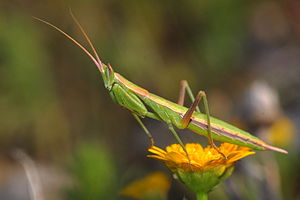Fuentes short-winged fishing insect
| Fuentes short-winged fishing insect | ||||||||||||
|---|---|---|---|---|---|---|---|---|---|---|---|---|

Fuentes short-winged fishing insect ( Apteromantis aptera ), male |
||||||||||||
| Systematics | ||||||||||||
|
||||||||||||
| Scientific name | ||||||||||||
| Apteromantis aptera | ||||||||||||
| ( Fuente , 1894) |
Fuentes rove-Mantis ( Apteromantis aptera ) is a Mantis from the family of Mantidae . It is named after the Spanish entomologist José María Hugo de la Fuente Morales and is one of the few fishing horrors in which both sexes are short winged.
features
The females reach a body length of 23 to 36 mm, males one of 27 to 28 mm, which makes Fuentes short-winged fishing insect the largest species of the subfamily Amelinae . The basic color of the species is mostly grass green, more rarely light brown or gray. The body structure of the fishing insect largely corresponds to that of other representatives of the subfamily. Here, too, the conically shaped and laterally pointed eyes protrude clearly above the head. The species also has long legs, which make the mantids fast runners and good jumpers. What is striking is the name-giving characteristic of the greatly reduced wings of both sexes, a characteristic that is rare in terrors. The notum of the subfamily-typical short thorax has its widest part almost in the center. The sexual dimorphism typical of fishing horrors is also present in Fuentes' short-winged fishing insects. The cerci of the males have a long and flat basic shape, those of the females are triangular and incised. The wider female has only six abdominal segments, whereas the male has eight segments and a narrower shape.
Occurrence
Fuentes short-winged insect has a small and patchy distribution area, which only extends over the central and southern part of Spain and the southern part of Portugal . There it inhabits mainly bushes and shrubs of dry and sunny hilly landscapes as well as grassy pastures and other areas with low vegetation of maquis and scrub . It often occurs in undisturbed open areas of the dehesas , on the edge of pine forests, hedges, vineyards and also along roads. Typical plants are fennel , wild carrot and the salt-tolerant sod Suaeda vera . The species has been proven up to an altitude of 1,300 meters.
Danger
Fuentes short-winged fishing insect is quite common within its habitat, but is often overlooked due to its camouflage. In the IUCN Red List, it is classified as "least concern". Nevertheless, due to the expansion of settlements and agriculture and the associated loss of their habitats, a decline of the less common species is feared. Another danger for the fans is the use of pesticides in agriculture.
Way of life

Like almost all fishing horrors, the Fuentes short-winged fishing insect is diurnal and shares its predatory way of life with all representatives of the order. It trains one generation a year . They overwinter as a nymph and ripen in May to June the following year. The range of prey includes any arthropods and other animals of suitable size, but locusts appear to be preferred . Fuentes short-winged terrestrial species inhabit both the plants and the substrate of their habitat and, like many terrestrial species, mostly remains motionless and thus largely goes unnoticed thanks to their camouflage.
Reproduction
Adults of the Fuentes short-winged insect can be found from autumn to winter (October to July). As with all species of the subfamily, the mating in the Fuentes short-winged fisherman is mostly peaceful without cannibalism on the part of the female. Some time after mating, the female lays up to four ooths of hard foam with a diameter of up to 10 mm. These usually contain 30 to 40 eggs.
Systematics
Fuentes short-winged fishing insect is one of only two species in the genus Apteromantis (the other is the North African Apteromantis bolivari ). When it was first described in 1894, José María Hugo de la Fuente Morales , after whom the species received its German name, first classified it in the genus Ameles and thus received the name Ameles aptera . William Forsell Kirby assigned the species in 1904 to the genus Pseudoyerseniaa . When Max Walter Peter Beier first described the genus Apteromantis in 1935 , he also included Fuentes' short-winged fan horror, so that it now received its scientific name that still exists today.
gallery
Individual evidence
- ↑ a b c d e f Description of Fuentes short-winged fishing insect on www.miteco.gob.es ( Link (Spanish))
- ↑ a b c d e Roberto Battiston, Joaquín Ortego, José R. Correas, Pedro J. Cordero: A revision of Apteromantis (Mantodea: Mantidae, Amelinae): A comprehensive approach to manage old taxonomic and conservation problems. In: Zootaxa . tape 3797 , no. 1 , 2014, p. 065-077 , doi : 10.11646 / zootaxa.3797.1.8 ( consevol.org [PDF]).
- ↑ Classified endangerment of the Fuentes short-winged fishing insect from the IUCN ( [1] Link)
- ↑ Systematics of Fuentes short-winged fishing insect on mantodea.speciesfile.org ( [2] Link)




